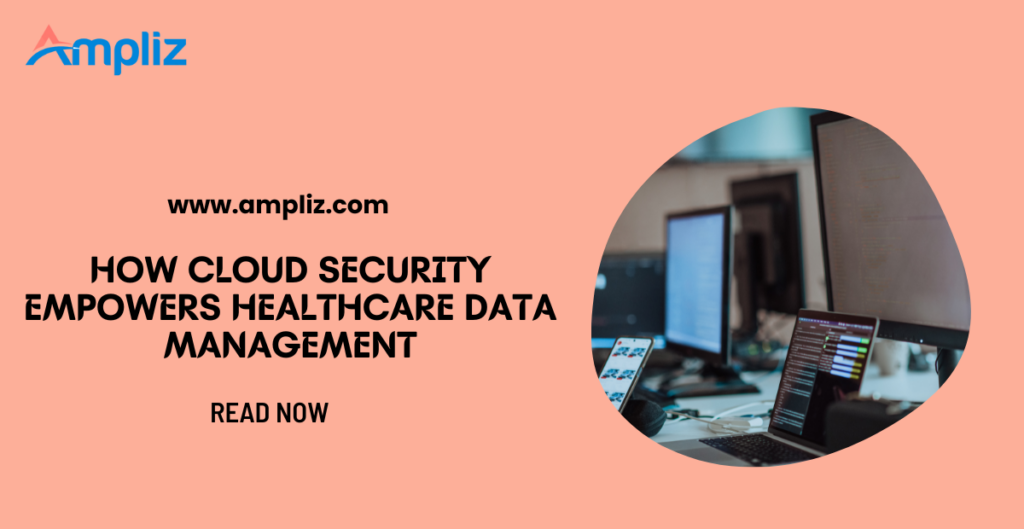Healthcare organizations have a mandate to protect patient data from misuse, loss and theft. Unfortunately the complexities of modern IT, as well as the vulnerabilities, can sometimes be a sticking point.
The good news is that with the adept implementation of cloud security in healthcare, professionals have less to fear. This is an epoch where trust meets technology, ensuring that confidentiality, integrity, and availability of healthcare data are guaranteed.
The stakes are high when a patient’s most personal information is committed to critical medical infrastructure. On top of security, providers can embrace precise healthcare data management to wrangle records with precision while exceeding privacy expectations.
Here’s a look at what this entails, and how it applies at a time when cyber threats are multiplying.
Explaining the imperative of cloud security in healthcare
Now more than ever, healthcare institutions are migrating to cloud-based systems – a shift driven by the demand for agility and scalability. However, this move amplifies the need for rigorous cloud security protocols.
From 2018 to 2023, the number of breaches caused by hacks in healthcare increased by 239%. Over the same period, ransomware attacks were up by 278%. Both of these threats can compromise poorly managed cloud security as well as on-premises setups.
With that in mind, here’s how superior cloud security transforms healthcare data management:
- Upholding Privacy Standards: Robust encryption and access control protect patient details from unauthorized eyes.
- Ensuring Compliance: Adherence to regulations like HIPAA is non-negotiable, with cloud security measures facilitating this compliance.
- Solidifying Data Integrity: Effective defenses shield against alterations or corruption, maintaining the accuracy of medical records.
- Minimizing Downtime Risks: Advanced threat detection capabilities keep critical systems operational, sidestepping costly interruptions.
For more detail on these measures, Wiz offers an in-depth way to learn about cloud security in its article. Of course even having a superficial overview will help you appreciate the importance of them, and what’s at stake.
Focusing more on the compliance aspect
As mentioned, cloud security in healthcare is necessarily intertwined with regulatory standards for compliance. This is not just about patient privacy either, since healthcare breaches can cost organizations an average of $11 million per incident. No other industry niche has such a steep financial tumble to take if data is compromised. As such, there really is no wiggle room when it comes to sticking to the rules.
Here are key ways that cloud security ensures compliance, even in the face of stringent legislation:
- Risk Assessment Protocols: Identify and mitigate vulnerabilities before they become entry points for data breaches.
- Data Protection Policies: Implement safeguards like multi-factor authentication and end-to-end encryption in line with regulatory requirements.
- Audit Trails: Maintain comprehensive logs that document access and changes to health records, essential for compliance audits.
- Regular Updates: Stay ahead with continuous updates to meet evolving standards set forth by authorities like HIPAA and GDPR.
A point worth driving home here is that data compliance is important regardless of the size of the organization. It doesn’t matter if you’re a small business or a huge corporation. Dealing with healthcare data means adhering to the same rules. The right cloud infrastructure, properly secured and implemented, can make this painless.
Revealing the role of cyber hygiene in cloud security
Unpatched vulnerabilities are inexcusable, and yet they account for a significant number of breaches each year. Evidence gathered by Tenable even found that flaws dating back to 2017 are still persisting and being leveraged by cybercriminals today. Implementing fundamental cyber hygiene practices through cloud security can dramatically reduce such risks.
Here are good habits that allow for more resilience in healthcare data management:
- Regular Software Updates: Patch systems promptly to repair security flaws and strengthen defenses against new threats.
- Employee Training Programs: Equip staff with the knowledge to recognize and avoid phishing attempts and other social engineering tactics. We’ll go into more detail on this aspect later, so stick with us!
- Strong Password Policies: Advocate for complex passwords which are also changed regularly to further restrict unauthorized access.
- Incident Response Planning: Have a well-practiced action plan ready to execute when potential breaches are detected.
This is all part of recognizing that the most vulnerable part of any system is often the human at the keyboard. If you are patching properly and training adequately, cloud security holes can be closed quickly.
Striving for continuity of care
Uninterrupted access to healthcare services is vital. Yet a cyberattack can impede this flow, with the worst instances requiring months of recovery. Cloud security in healthcare solidifies the continuity of care by creating robust safeguards against downtime and data loss.
Here’s how it afford all organizations and end users uninterrupted service:
- Redundant Data Storage: Cloud environments store data in multiple locations, ensuring availability even if one server falls victim to an attack.
- Automated Backups: Regular, encrypted backups preserve critical patient information, enabling swift recovery from disruptions.
- Disaster Recovery Plans: Strategically planned recovery protocols minimize service interruptions during various crises.
- Proactive Monitoring Systems: Early detection of abnormal network activity prevents cascading failures across healthcare systems.
In essence, cloud security is the support structure that ensures healthcare delivery remains consistent and reliable. And since 55% of people have had their trust in healthcare compromised, this is also a way to win them back. Again, we’ll circle back to this with added depth a little later, so it’s well worth reading further.
Tailoring cloud security to healthcare needs
Customization has to be prioritized in healthcare, both for better patient outcomes and in terms of data security. Since misconfigurations of cloud environments have caused vulnerabilities in 98.6% of organizations, according to Zscaler, this must be handled rigorously.
Here’s how to ensure customized security serves as a strategic defense for sensitive health data:
- Data Access Governance: Implement role-based access controls to ensure only necessary personnel handle sensitive data.
- Advanced Threat Detection: Utilize AI and machine learning tools for anticipating and neutralizing threats specific to healthcare systems.
- Patient-Centric Encryption: Customize encryption techniques based on the type of data and its usage within the healthcare workflow.
- Network Segmentation: Create secure zones within the cloud to prevent widespread access if a breach occurs.
Formulating defenses that mirror an organization’s unique risk profile should be a given. If not, the fallout can be devastating, as described earlier.
Revisiting the human factor
We’ve already touched on the fact that human error is a major contributor to security breaches in healthcare data management. It’s claimed that between 88% and 95% of data mishaps are down to people rather than firewalls or software flaws. In the healthcare sector, where stakes are high, addressing the human factor through training and policymaking is the answer.
Here’s how empowered personnel can act as an active line of defense:
- Ongoing Security Awareness Programs: Educate staff regularly on the latest cyber thre
- ats and prevention techniques.
- Simulated Phishing Exercises: Conduct mock attacks to sharpen employees’ vigilance against sophisticated scams.
- Clear Reporting Procedures: Establish and communicate protocols for reporting suspected cybersecurity incidents promptly and clearly.
- Access Management Workshops: Advocate for secure authentication practices among all levels of healthcare personnel.
Healthcare is necessarily human-focused, and so as long as this is the case, it has to be counted as part of data security management.[0
Future-proofing with cloud security innovations
Technology’s pace spares no one, and for cloud security in healthcare, being behind can mean being vulnerable. Investment in innovation is crucial, and there’s up to $170 billion of value to unlock by making this switch. This makes it less of a struggle to justify the upfront cost of making sure cloud infrastructures are properly future-proofed.
Here are some strategies to consider in this context:
- Adoption of Zero Trust Architecture: Implement strict identity verification for every person and device accessing the network.
- Integration of Blockchain Technology: Enhance data integrity and traceability through decentralized storage solutions.
- Embracing Quantum Cryptography: Prepare for next-gen encryption to combat emerging quantum computing threats.
- Leveraging Big Data Analytics: Use predictive analytics and data intelligence for threat modeling and real-time security decision making.
Engaging with these frontier technologies allows healthcare providers to contend with nascent threats while still focusing on patient care excellence.
Measuring cloud security’s impact on patient confidence
The shaky nature of patient trust in healthcare data management practices has already been discussed. Still, there’s no question that cloud security directly influences confidence in organizations that use it. Let’s dissect how this can be cajoled into motion:
- Transparent Data Practices: Communicate clearly with patients about how their data is protected in the cloud.
- Certifications and Seals: Obtain and display cybersecurity certifications as a sign of commitment to safeguarding patient information. This could include ISO 27001, which is geared towards making information security management systems better protected.
- Patient Portals with Robust Authentication: Provide secure access points for patients to manage their health records, enhancing perceived control over personal data.
- Regular Security Updates: Inform patients about ongoing improvements in security measures, reinforcing institutional reliability.
Deepening trust through demonstrable cloud security caters to current patients and newcomers alike. So both retention and conversion rates can be pushed in the right direction with this set of strategies.
Encouraging collaboration between healthcare and cloud security providers
Partnerships in progress are monumental, especially when they contribute to the safeguarding of health information. When healthcare entities and cloud security providers work together, great things can happen. This is particularly relevant as electronic medical records (EMRs) are being pivoted to the public cloud, with a 30% cost reduction resulting from this.
Here’s how this alliance fortifies the industry:
- Joint Compliance Efforts: Work hand-in-hand with vendors to ensure regulatory adherence across different jurisdictions.
- Shared Threat Intelligence: Benefit from collective knowledge on emerging threats, enhancing preventative measures.
- Co-Developed Security Solutions: Tailor security tools specifically for the unique needs of healthcare data systems.
- Round-the-Clock Support: Leverage the dedicated expertise and support that cloud security partners offer.
Through such strategic collaborations, healthcare organizations can adopt new technologies and also co-author the future shape of secure patient care.
Combining cloud security and healthcare innovation
In the pursuit of progress, balance is imperative. The healthcare sector’s engagement with technology must meld innovation with ironclad security.
This delicate balancing act is achieved by:
- Prioritizing Patient-Focused Features: Innovate with telemedicine and patient portals without compromising on data protection.
- Emphasizing Agile Development: Implement secure yet flexible cloud infrastructures that can adapt to new healthcare technologies.
- Layered Defense Strategies: Integrate multiple levels of security to protect against a variety of attack vectors.
- Evaluating Vendor Ecosystems: Scrutinize third-party providers for their commitment to cutting-edge security alongside innovative solutions.
A balanced blueprint not only accommodates current technological advances but also paves the way for safe, future healthcare breakthroughs.
Investigating crisis response from a cloud security perspective
When calamities occur, healthcare systems must be ready, with both physical assets and virtual ones requiring resilient designs. The readiness of cloud security systems has a direct impact on healthcare’s emergency response capabilities. Indeed 36% of decision-makers see disaster recovery as the main reason to motivate their cloud migration efforts.
Here’s how cloud security readies healthcare organizations for emergencies:
- Rapid Scalability: Adjust resources quickly to handle increased demand during health crises.
- Resilient Infrastructure: Ensure critical applications are always available, even under duress.
- Data Recovery Solutions: Implement swift data restore processes to bounce back from cyber incidents.
- Remote Collaboration, Unhindered: Secure telehealth and remote workforces become essential in pandemic responses.
These measures underpin the resilience necessary for healthcare providers to continue serving communities when it matters most.
Conclusion
The culmination of all this is the clear idea that cloud security really can empower those responsible for healthcare data management. But more than that, it’s good news for all stakeholders in this scenario – patients included. And they are the most important cog in the healthcare machine
The other key takeaway is that cybersecurity more generally will only become a bigger priority as time passes. It may seem all-consuming today, but cloud migration’s growth will soon turn even more of the spotlight its way. So the organizations that are prepared and informed now will be those that remain in control of their cloud-based destinies.



